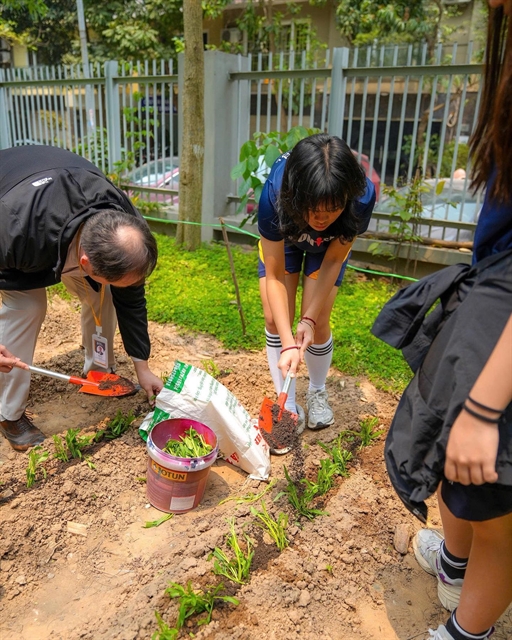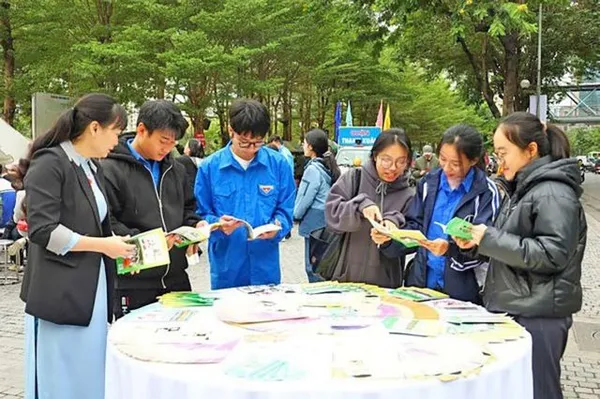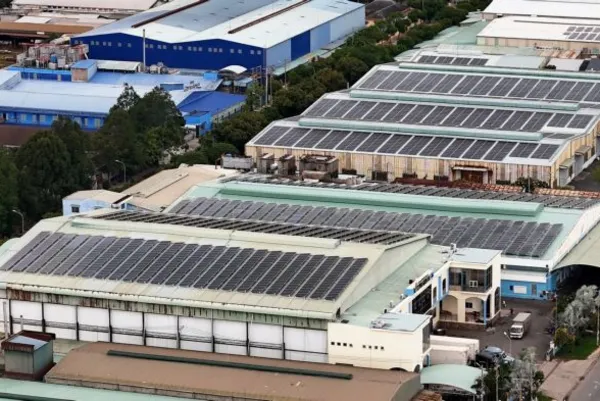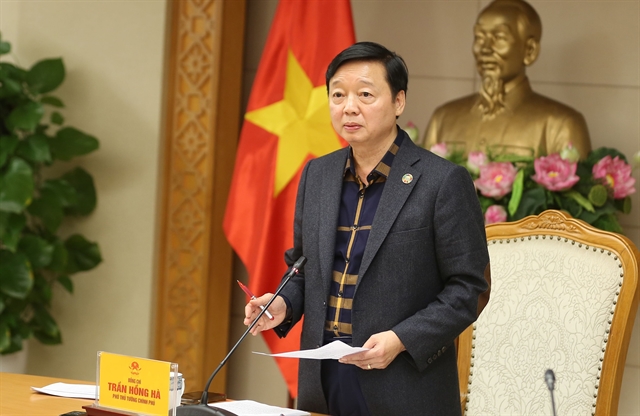 Environment
Environment

 |
| The Deputy Director of Phù Yên Forestry Company, Vi Hồng Sơn, visiting a recently-established pine forest under the company's care in Phù Yên District, within the northern mountainous province of Sơn La. — VNS Photo Nguyễn Hằng |
Nguyễn Hằng
SƠN LA — The Deputy Director of Phù Yên Forestry Company, Vi Hồng Sơn, is visiting a recently-planted pine forest under the company's care in Phù Yên District, the northern mountainous province of Sơn La.
The trees, just under a year old, are part of a 7.5ha protective forest initiative aimed at mitigating floods and enhancing environmental resilience for the district.
Sơn said the area was previously covered only by vegetation.
However, thanks to support from a project of the Japan International Cooperation Agency (JICA), the land has been transformed through afforestation efforts, contributing to the region’s ecological security.
The trees are growing well thanks to the dedicated care of the company's forestry workers, he said.
“After a few years, the pine trees will grow tall, giving green canopy throughout the forest,” he said.
In addition to the 7.5ha of protective forest, the project has also supported the planting of 5ha of Wurfbainia sp. (sa nhân) under the forest canopy and another 5ha of commercial Eucalyptus trees, a species known for its rapid growth and high economic value.
The plantations are expected to boost the company's revenue and provide resources to maintain and manage the protective forest areas under its stewardship in the future.
The initiative, part of the Project on Enhancing Sustainable Natural Resource Management (SNRM2), was launched on May 12, 2021 by JICA, in partnership with the Ministry of Agriculture and Rural Development (now the Ministry of Agriculture and Environment) in four provinces of Hòa Bình, Sơn La, Lào Cai and Tuyên Quang.
The project spans four and a half years with a total budget of about JPY613.1 million, including JPY500 million (around US$4.8 million) in non-refundable ODA and VNĐ25 billion ($1.08 million) in funding from the ministry and participating provinces.
The project includes the formulation of the company’s sustainable forest management plan as required by the Law on Forestry, the planting of Wurfbainia sp. on 4ha of natural production forest, the planting of tissue-cultured Eucalyptus on 5ha of production forest and the planting of Pinus massoniana (Thông mã vĩ) on 7.5ha of protection forest.
Recognised achievements
(1).JPG) |
| The Eucalyptus plantation forest area seen from the air.— Photo courtersy of JICA Việt Nam |
Deputy Director of the Sơn La Province's Department of Agriculture and Environment Trần Dũng Tiến said the province, one of the top three in the northern mountainous region, has an estimated 670,000ha of forest.
Ethnic groups comprise 84 per cent of the population and a significant portion of livelihoods are forest-based.
“This is why we always prioritise forest development and forest-based livelihoods,” Tiến said.
He also said the province highly appreciated the project’s effectiveness.
The first phase of the project helped shape forestry development plans and build the capacity of key personnel, notably the forest rangers.
With the project's support, the province acquired advanced technologies, training and forest monitoring equipment, leading to marked improvements in forest management and protection.
The second phase, launched in 2021 in Phù Yên District, has continued with technical support for growing Wurfbainia sp. beneath tree canopies and establishing eucalyptus and pine plantations.
The company is the designated implementing agency.
“We’ve gained experience and a data foundation for medium-term agroforestry planning for 2026–30 through the project,” Tiến added.
“It also helped to build provincial resolutions and support mechanisms for forestry development.”
Kim Văn Tĩnh, director of the company, which currently manages more than 8,100ha of forest, consisting of 7,200ha of protective forest and 900ha of production forest, said under the provisions of the 2016 Forestry Law and Decree No. 156, the company must develop a plan for sustainable forest management and protection for the 2021-30 period.
The management plan includes diverse elements, from biodiversity assessments and genetic conservation to forest production planning and monitoring, he said.
“Each component requires field-specific experts. For instance, biodiversity tracking involves weeks in the forest using camera traps and data collection tools.”
The estimated cost of preparing such a plan is around VNĐ1 billion ($38,000).
"Thankfully, in 2021, we were selected to join the project following recommendations by the provincial authorities and forestry department," he said.
“Without the project’s support, we wouldn’t be able to develop the plan.”
Beyond planning, the project has provided firefighting equipment, GPS devices, binoculars and safety gear to support forest patrols and annual monitoring.
Between 2023 and 2024, the project has further assisted with establishing 5ha of Wurfbainia sp., 7.5ha of pine protective forest, and 5ha of production eucalyptus, planting out high-yield tissue culture varieties.
“The protective forest is now nearly a year old and thriving, with a high survival rate,” he said.
"The commercial forest will generate much-needed income, improving wages for our workers, who currently earn just VNĐ1.8 million ($70) per month," he added.
The Chief Advisor to the project, Baku Takahashi, emphasised the goal of enabling the forestry company to independently sustain its model.
He said with the Wurfbainia sp. planting model, it is hoped that the company can create additional revenue to partly offset the salary expenses for staff, expenses for afforestation activities and protection of protective forests.
Protective forests don’t generate revenue as trees can’t be harvested, he said.
That’s why the project support the planting of eucalyptus in production forests, these can be harvested, providing income to support protection efforts.
“We also did a lot of training for the company, so the company can know how to establish the plantation, how to maintain it in the future,” he added.
Tapping carbon market potential
Tiến said the province has a strong potential to engage in future carbon markets.
In the first phase of the project, the province developed a carbon inventory database.
Under current forestry policy, carbon is recognised as a source of forest environmental income.
However, Việt Nam still lacks a national framework for carbon market operations, trading platforms and clear guidelines for voluntary or mandatory market participation, he said.
On June 17, 2022, the Government Office issued Notice No. 176/TB-VPCP concluding that Prime Minister Phạm Minh Chính agreed in principle to allow Sơn La Province to develop and implement the Project of 'Piloting forest carbon credit trading'.
To prepare for this, the province is working with domestic and international organisations to improve capacity to access the carbon market, as well as helping the province develop measurements to be ready to participate when the market officially operates, he said.
A provincial task force, led by the Vice Chairman of the provincial People’s Committee, is coordinating this effort.
It is hoped that by 2027–28, in line with Decree No. 06/2022 on greenhouse gas emissions reduction and ozone layer protection, Việt Nam will finalise its legal framework for carbon credit trading, he said.
According to the Ministry of Agriculture and Environment, preliminary estimates suggest the province could generate around 1.2 million forest carbon credits annually.— VNS




